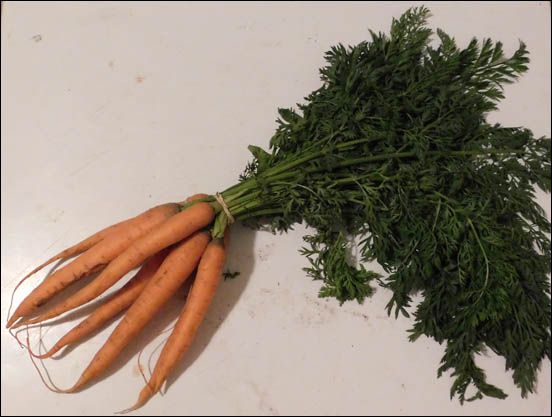Carrots

CARROTS

BASIC IDENTIFICATION:
- Name: Carrot, Daucus carota.
- General Description of the Plant: Carrots are of the type of plants that develop an eatable root in the ground, aka a "root vegetable". The leaves are also eatable, but were originally grown for their fragrance. Carrot's root crown will form leaves in a spiral rosette and at maturity can spread out over 12-18".
The taproot itself is typically orange, though a wide variety of cultivar colors exist. Over the growing season, the root will expand and fatten, storing food for the plant's first Winter. Carrots are "biennial", that is their lifecycle spans two years.
- Why We Grow This? (common uses): The taproot of a carrot is eaten. The leaves and seeds can be eaten too, though the leaves are often collected for their aromatic smell.
- Historical Facts and Quotes: History indicates that the wild carrot probably originated in Central Asia and Persia (modern day Iran and Afghanistan). Early carrots were predominately purple in color, though by the 11th century red and yellow cultivars began appearring. The traditional orange colored carrot first appeared in the Neatherlands in the 17th century, being noticable due to the color orange being associated with the Dutch flag.
Eating carrots is associated with better night vision, but this is untrue. In fact the story that they do, was created by the British government during early World War 2, which attributed the good performance of English pilots fighting the Germans. This was a cover to hide the new use of radar.
- Can Be Confused With: None known.
- Cautions and Hazards: Leaves if eaten should be in moderation. Some sources suggest carrot leaves contain harmful levels of alkaloids.
A small percentage of people are allergic to carrots (about 3-5%).
CULTIVATION:
- Popular Variations and Cultivars (text) .
- Starting: from seed; from cutting; by root stock, rhizome, bulb, grafting; other (text) .
- Bedding Out: plant spacing, soil temperature, soil amendments, best rotation cycle. (text) .
- Best soil type: Loamy, moist; Sandy, well-drained; Mineral-dense, clay (text) .
- Sowing Season & Habits: Annual, Perennial, Biennial, self seeding, self pollinating, dioecious (text) .
- Plant Health maintenance: diseases, pests, treatments, cold shelters, interventions (text) .
- Companion Planting (text) .
HARVEST
- Signs of ripeness, over- and under-ripe (text) .
- Gathering tips. Gloves, techniques (text) .
- Preserving and Storage (text) .
- Post-harvest soil care and compostable wastes (text) .
COOKING AND EATING:
- Nutritional Information: (text) .
- How to prepare before eating: (text) .
- Useful recipes and cooking hints: (text) .
- Historical dishes and meals: (text) .
- Non-Food Usages: (text) .
SEEDS
- How This Plant Propagates: (text) .
- Harvesting Seeds: (text) .
- Seed Storage: (text) .
OTHER INFO
- Green Wizard forum links
Wasting Good Food Because Of Beauty
- Outside Links
- Helpful Books
- Contributors